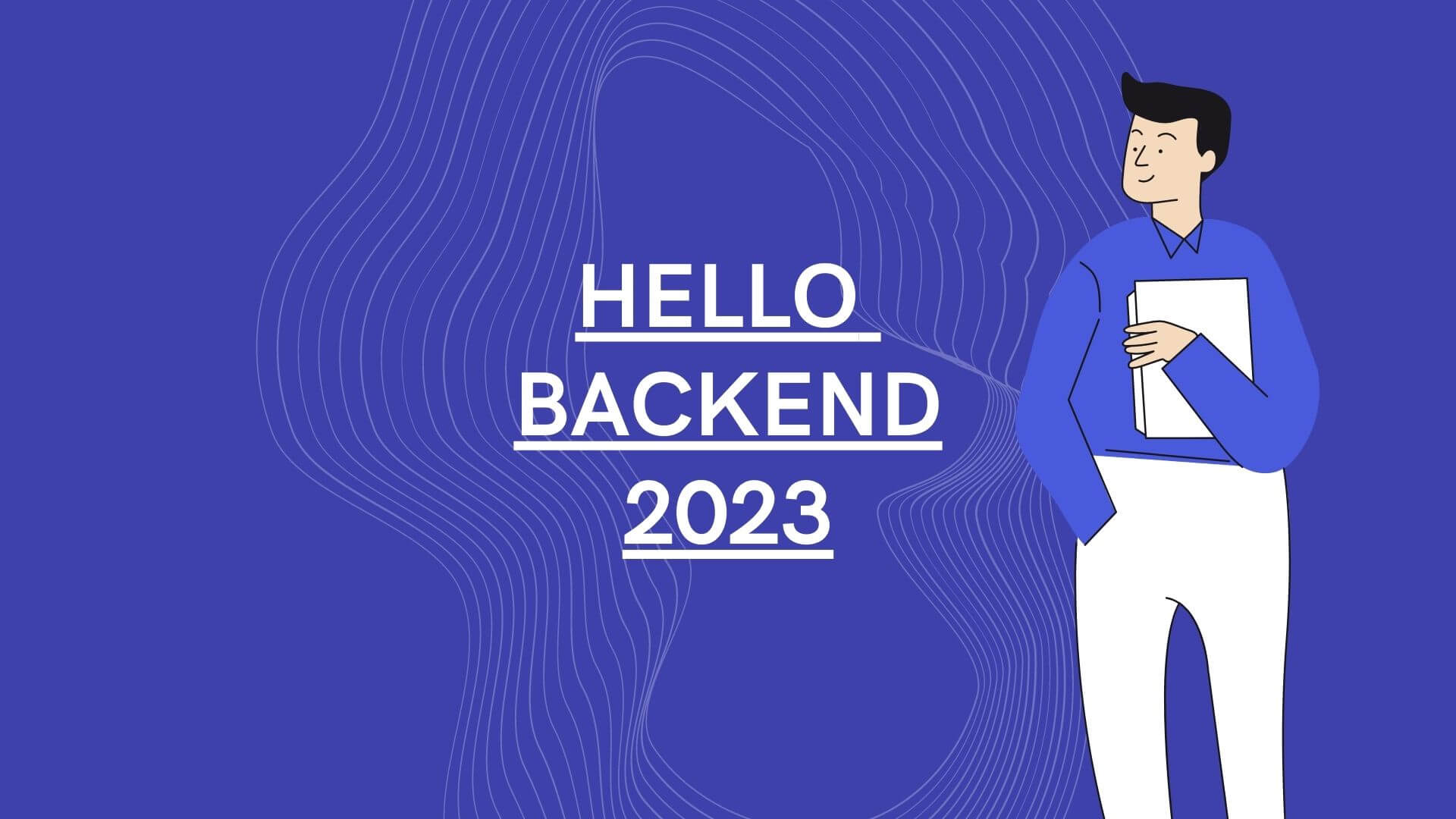So you have decided to join the ranks of the not so elusive Node.js backend developers. This could be the best decision you’ve made or the worst depending on who you are. However, since we haven’t had a meet and greet we would assume that this leans more towards an awesome decision, because you are here, putting in the work to learn to become a backend developer and I am just in the position to let you know how with a few tips, tricks and suggestions.
Who is a Backend Developer?
A backend developer is a specialist in the art of handling data, connections and servers in software development. Backend developers do not only build APIs, they also make crucial decisions on architecture and flow. They are the wizards behind the functionality of your websites and apps, making sure that all that beautiful user interface (buttons, pages) have great functionality that allows the app or site to run smoothly. A good analogy for backend development lies in a restaurant. The frontend could be likened to the charming waiter who takes your order with a smile, in a well-lit and beautifully designed space. The kitchen though, where the meal prep happens could be the backend. The restaurant may be straight out of a fairy tale and the waiters are all beauty standard models, but if the food sucks, takes too long to be prepared or is unavailable, your experience of that place would generally suck too. With this analogy, we see the importance of backend development. If this excites rather than intimidates you, then you’re in the right place.
So What is Node.js?
To be a backend developer, you must attain relative mastery of a programming language. There are several of these languages to choose from that range from Python, Rust, Java, C to even machine language (which I won’t advise you go for). JavaScript is a popular language used on the backend, even though this wasn’t always the case as you would find in this article. Due to its runtime environment - Node.js, it no longer lives simply in web browsers but can be used to build a number of apps, games and sites. Node.js, which was written by Ryan Dahl in 2009 was intended to be used to let JavaScript out of the web browser bubble so that it could breathe life into other software. This became a great success and now Node.js boasts of about 36.42% of professional developers worldwide using it to set up servers, handle databases and carry out other tasks.
Why You May Opt for Node.js in Backend Development
There are several reasons why Node.js is a great choice for backend development, but we would be examining only a few of those here.
A Rich Ecosystem
JavaScript is largely one of the most utilized programming languages in the world. This means it boasts of a rich ecosystem. The Node Package Manager (NPM) offers the largest collection of open source libraries in the world, with a package available for almost any need be it web scraping, email handling or automation. This means that getting your APIs up and running as a Node.js backend developer is pretty easy.
Real-Time Support
Node.js is great with real-time backend applications like chat apps, multiplayer games, notification features and more.
A Vast Number of Frameworks
It’s almost inconceivable to imagine what life would be like now if we had no frameworks like ExpressJS or NestJS to get our backend apps running. While there is nothing wrong with setting up servers from scratch, it helps to know that backend developers can save time, focusing on the implementation of the logic for their programs and leaving the scaffolding to Node.js frameworks.
No Hassle with APIs and Microservices
Node.js was made for API building. Architectures like GraphQL and REST are largely supported and its reliance on JSON for data representation is great for APIs.
Massive Community Support
As stated earlier, Node.js is pretty popular. Companies like Uber and Netflix support its use and with a developer community spanning the tech landscape like the stars in the heavens it’s no wonder why. This means that new developers and experienced ones would always find documentation, tutorials and online communities to lean on for help when long debugging nights bless them with eye bags.
These are only a few of the reasons why leaning into a career as a Node.js backend developer is a great choice. In the coming section, we’ll explore a structured roadmap to its mastery. You should note however, that you are free to tweak and bend the rules of this section as it suits you, but consider it a generalized path to a career in Node.js backend development.
A Roadmap to Becoming a Node.js Backend Developer
Whether you’re learning independently, attending a bootcamp, or supplementing a computer science degree, the core of becoming a Node.js backend developer remains the same - you’ll need to learn, build, and keep improving. We would be exploring this on a timeline basis – from the moment you see that glistening “Hello world” text in your terminal to the moment you receive an email stating your successful employment. Beyond this, there is bound to be some point in your career where you would consider a switch to farming, but we would not be heading that far here.
Your First Hello World (0 – 3 Months)
You have done it all, downloaded VS Code, installed the necessary extensions and named your new file “hello.js”. You go on the screen and type the line that prints a text (“Hello World!” in this case) to the terminal as shown:
<pre><code class="language-javascript">
console.log("Hello World!") // Mama I made it!
</code></pre>That excitement? Priceless. Now you realize that this is your calling and you were made to be a developer. In the first three months, you experiment. The results of your experiment determine what you are most comfortable with – frontend or backend. Staying true to the title of this article, let’s say you go for backend development. Now is a good time to begin learning the basics of the language using tools and sites. When you feel moderately comfortable, you begin to solve coding questions on platforms like the famous (or infamous?) leetcode. At this point, you are not concerned much with optimizing your solutions, your focus is on ensuring that you have solutions that work. This practice helps you learn the nuances of JavaScript and some of its peculiarities.
The First Dive into Backend Concepts (3 – 6 Months)
So you’ve learnt enough of the basics of programming and JavaScript, solved a bunch of leetcode questions (you’ve started to optimize your code) and are ready to start building APIs for real. You begin building projects that range from your weather app to your to-do list. You pick a framework at this stage to learn which tends to be ExpressJS. If you choose (which I highly recommend you do), you practice using TypeScript as well which may lead you to learning how to use the NestJS framework.
However, before picking up a framework, you should ensure that you know enough of plain Node.js and JavaScript to stand your ground when you need to debug your APIs. When you feel comfortable enough, you pick up that framework and get to building. It is also important at this stage to know a little bit of the frontend. It could be basic HTML and CSS, something you could use as an interface for your awesome APIs because no one really cares to see the image below, no matter how beautiful you find well retrieved data.
Who needs the frontend? (Image Source: programmerhumor.io)
As you build, be sure to set up a Github account and learn about Git version control, so you can save up your amazing projects and show them to friends and potential employers. You may consider your to-do list app API simple, but when well executed it could lead you to internships and other opportunities.
At this stage be sure to learn about backend concepts even if you don’t fully understand them yet. These concepts could be architecture styles, rate limiting, middleware, authentication and authorization, data validation, database management (you could begin learning to use an SQL or NoSQL database), environment configurations, error handling and a host of others. No one learns everything before they get a job as a backend developer, so you should not pressure yourself to know everything but pay more attention to knowing what you know well.
Off the Training Wheels (6 Months – 1 Year)
Now you are suited with a GitHub account of great projects, a knowledge of programming particularly rich in backend concepts and are now ready to slay the dragon – the job market. At this point, be open to applying for volunteering opportunities (yes, not paid ones too) and internships (also don’t shy away from the unpaid ones). These opportunities help provide you with real world experience in Node.js backend development, as well as give you a glimpse into working in teams. You build software that you’re proud of and can show off for job interviews.
It is also great here to get involved in open source projects. These give you an opportunity to flex your Node.js backend muscles and are great to put on your ever growing CV.
Soon, you may decide to hop into the job hunting scene and get paid for all the hard work you’ve put in. This is a great time to practice more leetcode questions, as well as questions pertaining to your problem solving process as a lot of times in your backend career you won’t be typing non-stop on a suffering keyboard, but be thinking, like a statue by Auguste Rodin.
Being A Node.js Backend Developer (1 Year – Your Choice)
Soon after with all the hard work put in, you’ll be employed and get to be a junior developer in a team of others more experienced in the art of Node.js than you. Don’t fret and remember the number of hours you’ve put in to be where you are. Be open to failing sometimes and never shy away from asking for help. Senior developers in good teams are always happy to help because they understand what it was like to be where you are and code reviews exist for the purpose of bringing you up to speed on proper practices on the job.
With this, congratulations you are now a Node.js backend developer! After a couple of years you’d transition into senior developer status and then eventually become a farmer, if that’s your thing.
Node.js Project Ideas for Aspiring Backend Developers
While I have provided you with a generalized timeline for your transition into Node.js backend development, I am yet to specify what projects would help guarantee your steady growth and eventual employment as a backend developer. A few of these projects are briefly examined in this section.
Authentication and Authorization System
Building a user authentication and authorization system could help solidify concepts like middleware and hashing. It also helps one understand role-based access and encourages practice with JSON Web Tokens (JWT).
Blog API
One could build a CRUD API for creating, reading, updating and deleting blog posts. With this an aspiring backend developer would be learning about directory structure, routing, database operations and the use of authentication and authorization.
Real-Time Chat App
This project would ensure that one learns about Websockets, data storage and real-time events. The app would be built using Socket.IO and MongoDB (Or some SQL database).
File Upload API
As the name implies, you would learn to build an API that uploads images or files and returns download links. This project would show you how to use Multer or Cloudinary. You would learn about cloud storage (if using Cloudinary), file handling and security.
E-commerce API
This could be considered a holy grail when it comes to learning Node.js backend development. This is because you would have the opportunity to learn about CRUD, relational data, REST, payment APIs and data handling. It forces you to think about architectural decisions and is generally a great project to share.
These are only a few of the projects you could build as an aspiring Node.js backend developer. If you’re looking to expand your skill set, there is a great selection of projects available just waiting to be built by you.
Conclusion/ Summary
Backend development is a core element of software development. Node.js is great for backend development due to a number of reasons that range from its rich ecosystem to its impressive community support. With a structured approach, becoming a Node.js backend developer is possible and there are several projects available to aid in its realization.




